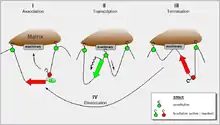Matrix Attachment Regions
Les MARs ou Matrix Attachment Regions sont des séquences d’ADN eucaryote associées à la matrice nucléaire pendant l’interphase [1]. Ces éléments jouent un rôle dans la structure de la chromatine[2] - [3], en organisant le génome des cellules eucaryotes en boucles indépendantes de chromatine[4]. Une telle ségrégation de la chromatine permet de former des régions d’ADN décompacté, plus accessible à la machinerie de transcription[5].

Propriétés dynamiques des interactions matrice nucléaire /S/MAR.
Notes et références
- Hart C, Laemmli U. 1998. Facilitation of chromatin dynamics by SARs. Curr Opin Genet Dev 8 : 519-525.
- Mirkovitch J, Mirault ME, Laemmli UK. Organization of the higher-order chromatin loop: specific DNA attachment sites on nuclear scaffold. Cell. 1984 Nov;39(1):223-32.
- Breyne P, Marc van Montagu et Godelieve Gheysen. The role of scaffold attachment regions in the structural and functional organization of plant chromatin. Transgenic Reseach. 1994
- Heng HH, Krawetz SA, Lu W, Bremer S, Liu G, Ye CJ. Re-defining the chromatin loop domain. Cytogenet Cell Genet. 2001;93(3-4):155-61.
- Ruh MF, Dunn R 2d, Ruh TS. Interrelationships between nuclear structure and ligandactivated intracellular receptors. Crit Rev Eukaryot Gene Expr. 1996;6(2-3):271-83.
Cet article est issu de wikipedia. Text licence: CC BY-SA 4.0, Des conditions supplémentaires peuvent s’appliquer aux fichiers multimédias.